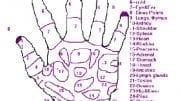Sickle cell anemia is a hereditary disorder that occurs when a person inherits two abnormal genes (one from each parent) that cause their red blood cells to change shape. Instead of being flexible and round, these cells are more rigid and curved. The shape is similar to a crescent moon.
Normal red blood cells are shaped like doughnuts with the centers partially scooped out and are soft and flexible.
Unlike normal red blood cells that last about 4 months in the bloodstream, fragile sickle cells break down after only about 10 to 20 days, which usually causes anemia.
Signs and Symptoms
Teens with sickle cell anemia may develop jaundice, a condition that results from the high rate of red blood cell breakdown. Jaundice can cause the skin and the whites of a person’s eyes to develop a yellowish tint.
 Image via Wikipedia
Image via WikipediaWhat Do Doctors Do?
To diagnose sickle cell anemia, doctors use a blood test called hemoglobin electrophoresis
There is no cure for sickle cell anemia, and it is possible for some people to die from the disease
Doctors can provide treatments that help prevent complications from the disease. Kids and teens who have sickle cell disease often take penicillin or other antibiotics to help fight infections.
What Can You Do to Stay Well?
With the right precautions, teens with sickle cell disease can do most of the stuff other teens do. To stay as healthy as possible, people with sickle cell anemia should take these steps:
? Eat a balanced, healthy diet.
Take vitamins, including folic acid supplements
? Drink plenty of water to prevent dehydration.
? Avoid extreme cold or heat.
Exercise regularly, but in moderation

![Reblog this post [with Zemanta]](http://img.zemanta.com/reblog_c.png?x-id=10b7e989-1058-4113-bbc7-802302ec3d3d)




Be the first to comment on "Sickle cell anemia"